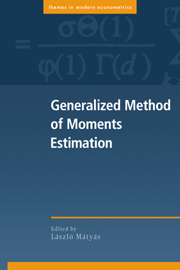Book contents
- Frontmatter
- Contents
- Contributors
- Preface
- 1 Introduction to the Generalized Method of Moments Estimation
- 2 GMM Estimation Techniques
- 3 Covariance Matrix Estimation
- 4 Hypothesis Testing in Models Estimated by GMM
- 5 Finite Sample Properties of GMM estimators and Tests
- 6 GMM Estimation of Time Series Models
- 7 Reduced Rank Regression Using GMM
- 8 Estimation of Linear Panel Data Models Using GMM
- 9 Alternative GMM Methods for Nonlinear Panel Data Models
- 10 Simulation Based Method of Moments
- 11 Logically Inconsistent Limited Dependent Variables Models
- Index
9 - Alternative GMM Methods for Nonlinear Panel Data Models
Published online by Cambridge University Press: 04 February 2010
- Frontmatter
- Contents
- Contributors
- Preface
- 1 Introduction to the Generalized Method of Moments Estimation
- 2 GMM Estimation Techniques
- 3 Covariance Matrix Estimation
- 4 Hypothesis Testing in Models Estimated by GMM
- 5 Finite Sample Properties of GMM estimators and Tests
- 6 GMM Estimation of Time Series Models
- 7 Reduced Rank Regression Using GMM
- 8 Estimation of Linear Panel Data Models Using GMM
- 9 Alternative GMM Methods for Nonlinear Panel Data Models
- 10 Simulation Based Method of Moments
- 11 Logically Inconsistent Limited Dependent Variables Models
- Index
Summary
In recent years the GMM approach became increasingly popular for the analysis of panel data (e.g., Avery, Hansen and Hotz [1983], Arrelano and Bond [1991], Keane [1989], Lechner and Breitung [1996]). Combining popular nonlinear models used in microeconometric applications with typical panel data features like an error component structure yields complex models which are too complicated or even intractable to be estimated by maximum likelihood. In such cases the GMM approach is an attractive alternative.
A well known example is the probit model, which is one of the work horses whenever models with binary dependent variables are analyzed. Although the nonrobustness of the probit estimates to the model's tight statistical assumptions is widely acknowledged, the ease of computation of the maximum likelihood estimator (MLE)—combined with the availability of specification tests—make it an attractive choice for many empirical studies based on cross sectional data. The panel data version of the probit model allows for serial correlation of the errors in the latent equations. The problem with these types of specifications is, however, that the MLE becomes much more complicated as in the case of uncorrelated errors.
Two ways to deal with that sort of general problems have emerged in the literature. One is the simulated maximum likelihood estimation (SMLE). The idea of this technique is to find an estimator that only approximates the MLE but retains the asymptotic efficiency property of the exact MLE. SMLE uses stochastic simulation procedures to obtain approximate choice probabilities (see e.g., Börsch-Supan and Hajivassiliou [1993], or Hajivassiliou, McFadden and Ruud [1996]).
- Type
- Chapter
- Information
- Generalized Method of Moments Estimation , pp. 248 - 274Publisher: Cambridge University PressPrint publication year: 1999
- 5
- Cited by

